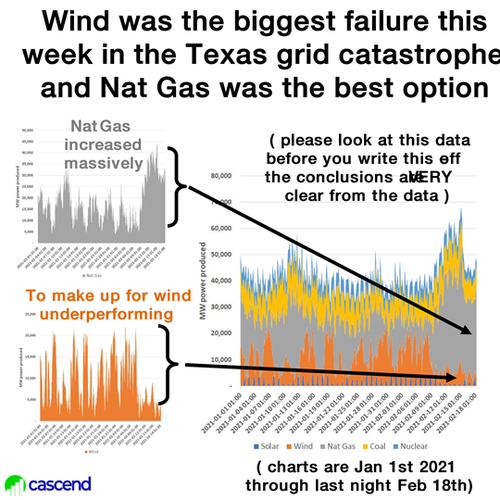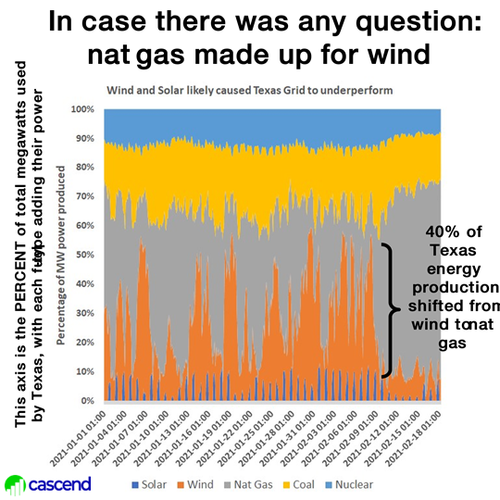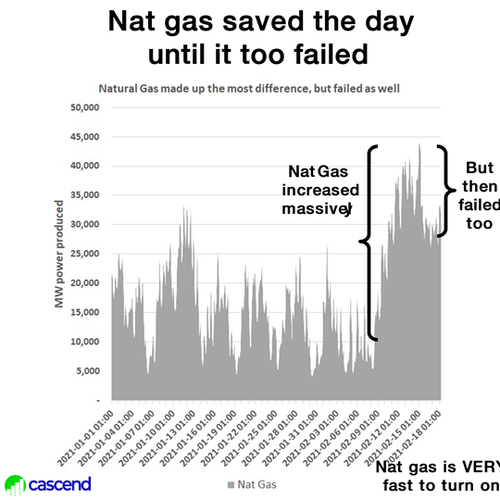Is there an irony that wind power is supposed to be the weapon against climate change (and weather whiplash),yet when a severe winter storm from the Arctic it is wind power that gives up the ghost.
Cascend: Data Shows Wind-Power Was Chief Culprit Of Texas Grid Collapse
20 February, 2021
With the worst of the Texas power crisis now behind us, the blame and fingerpointing begins, and while the jury is still out whose actions (or lack thereof) may have led to the deadly and widespread blackouts that shocked Texas this week, Cascend Strategy writes that "in case there was any doubt why the Texas grid collapsed, the data is clear"
Wind failed as “Ice storms knocked out nearly half the wind-power generating capacity of Texas on Sunday as a massive deep freeze across the state locked up wind turbine generators, creating an electricity generation crisis."
Natural gas made up the difference for a while
But then everything else followed down
Some more detail from Cascend which lays out the events of this week in sequence:
A massive cold snap drove demand for electricity well beyond normal levels
Wind power failed to deliver it’s expected power – almost 40% of expected power – in part due to lack of winterized wind turbines
- Natural gas (as always) made up the difference...
- but then suffered from lack of supply from non-winterized delivery
Coal and nuclear both underperformed, but not by much, due to non-winterized equipment
Solar underperformed for a few days but is back, although is far too intermittent to help without storage except during heat waves
And Texas’ grid couldn’t buy enough power from neighbors to make up the difference
Nor are power producers required to keep a reserve of power
The simple 5-step solution according to Cascend:
Winterize equipment
Require power reserve
Connect the Texas grid better
Add solar with storage (storage is key)
And add more natural gas
As some others have summarized the Texas disaster best...
It is sad and ironic that in a state known for its huge petroleum and natural gas resources, the lack of reliability of wind power has brought the state to its knees in a time of crisis, not unlike that which California experienced in 2020 during record heat where wind and solar power could not keep up with demand and was near collapse.
The folly of chasing renewable energy as a means of mitigating “climate change” is making itself abundantly clear today in Texas. When will politicians wake up and realize that renewable energy almost always equates to unreliable energy?
Did Wind Power Fall Hard During the Great Texas Storm? Yep. Twice.
Maybe not that last one. And we haven’t had a Super Bowl champion in much too long a time.
Anyway, Friday morning I pulled electric power generation data by source from the United States Energy Information Administration. EIA is reputable and authoritative, to the extent that any government agency is. Insert shrug emoji if you wish. I mostly trust their data. It’s EIA’s data everyone cites when they, accurately, say the United States reduced carbon emissions faster than other developed nations and ahead of the Paris Accords targets over the past few years. EIA’s data attributes that to the rise of natural gas as a cheap, reliable, and clean power source. So you’ve probably trusted their data too, whether you were aware of it or not.
Here’s what their Texas energy generation graph of the past week says.

The beige line at the top is natural gas, the green line in the middle is wind. Take note of what that line does between Feb 15-16 and then again on Feb. 17. Also take note of what the beige line is doing during that second period.
I’ll add some arrows to point out wind’s lowest generation points.

Just for perspective, let’s look at the past 30 days of Texas power generation, including this lousy week.

Other than a brief snowstorm in Austin on January 10 (about 1.5 inches), January was pretty mild, though colder than January 2020. The average temperature in Austin, which is pretty central, was 53.6 degrees. A year ago it was over 57 degrees.
I’m not here to bash or praise any particular power source. All-of-the-above is my way. But baseline performance and reliability, and the ability to throttle output to meet demand, have to be included in the discussion. It would be for the good of the state and the world to understand what happened and what can happen.
All the major power sources suffered compared to expected output to one extent or another during the storm that froze the whole state. But wind didn’t just dip, it collapsed, two times — according to the EIA’s data. You can see that more sharply in the 30-day graph than the 7-day graph. It has since bounced back, but so have coal and nuclear, after a freezing issue at the STP nuclear plant near Houston (that never put anyone in any nuclear accident danger).
The data tells a major part of the story of the past week. It also holds some lessons for the future.
Hydroelectric (the blue line) doesn’t produce enough to merit much discussion.
At the current level of storage technology, solar isn’t terribly viable yet. Solar also suffered a serious output loss in the storm’s early days according to the EIA charts.
Coal and nuclear (brown and purple lines respectively) are steady Eddies when we need them to be. Both dipped in output, but both were pretty reliable. Neither appears to be very capable of being throttled to meet demand when it surges. They provide steady baseline output. Coal output fluctuated a lot before the storm as wind was used more, but stepped up to provide pretty steady output until the 15th. That’s when the snow and ice storm was blanketing and freezing Texas, along with more than 70% of the whole United States. Nuclear dipped at the same time because of the STP issue.
Natural gas can be throttled when demand surges. It was, as the graph shows, though natural gas lines reportedly froze too. Overall it kept millions from freezing to death in their homes. Just look at its output line in the 30-day graph once the storm starts versus the weeks prior. It’s around 200% above pre-storm (mild weather) output. That’s amazing.
Wind is great when the weather is great. When the weather deteriorates, wind is liable to do the same as it is currently used in Texas.
Imagine a future in which we’re more dependent on wind but the turbines aren’t winterized. That won’t do. They won’t perform. So if we remain as dependent or become more dependent on wind power, we will have to mandate winterization. That will make them somewhat more expensive. Wind is already heavily subsidized — actual subsidies, not the ordinary business tax write-offs that Democrats claim are subsidies when discussing fossil fuels. So wind might get even more subsidies. I’m not advocating that, just reading the room.
We’re nowhere near the point of doing away with fossil fuels. That’s not in the cards for a long time. For one thing, you can’t even make many of the components for wind and solar generation without petroleum and the plastics derived from it.
Also imagine a future in which California wins and we’re all driving electric cars. The grid already can’t handle that, according to Elon Musk, though Texas’ grid is probably closer to handling it than others, thanks to natural gas. A full fleet of millions of electric cars would have contributed to obliterating the grid during this crisis. Texans also may not have been able to use their cars to keep warm when their home power went out.
Why?
Gas and diesel engines use the heat they generate from internal combustion to heat the cabin. Electric cars don’t. Their engines create very little heat. The fact that electric cars struggle in the cold is a known issue with them. They’d have drained their batteries if people had to use them to heat themselves and their loved ones during this crisis. Batteries also don’t perform as well in cold versus optimum temperatures between 60 to 80 degrees.
[W]hile an internal combustion engine generates its own heat, which warms the engine and the car occupants, an EV has to find that warmth somewhere else, either scavenging the small amount of heat that motors and inverters make or running a heater. That takes energy, meaning there’s less power available to move the wheels.
Additionally, to protect the battery—the most expensive component of an EV—the onboard computer may limit how it’s used in extreme low temperatures. The Tesla Model S owners manual warns: “In cold weather, some of the stored energy in the Battery may not be available on your drive because the battery is too cold.” Tesla adds a snowflake icon next to the range indicator to show it might be impacted. Typically, an EV will cover around 20 percent fewer miles in cold weather versus beach weather.
There goes the grid.
Bryan Preston served as chief of staff to Texas Railroad Commissioner Ryan Sitton. The Texas Railroad Commission regulates oil and gas production in the Lone Star State, which is the nation’s top energy-producing state. He is the author of Hubble’s Revelations: The Amazing Time Machine and Its Most Important Discoveries. He’s a veteran, author, and Texan.








No comments:
Post a Comment
Note: only a member of this blog may post a comment.